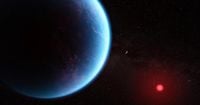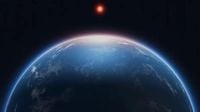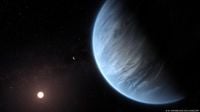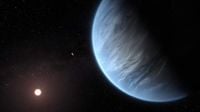Recent findings from the James Webb Space Telescope have sparked excitement in the scientific community, as researchers have detected potential signs of biological life on the exoplanet K2-18b. Located 124 light-years away from Earth, K2-18b is a super-Earth or sub-Neptune, roughly 2.5 times larger than our planet. The discovery of two molecules, dimethyl sulfide (DMS) and dimethyl disulfide (DMDS), in the planet's atmosphere has led scientists to consider the possibility of microbial life existing there.
The team of astronomers from the University of Cambridge, led by Professor Nikku Madhusudhan, announced their findings on April 17, 2025. They revealed that DMS and DMDS are gases produced exclusively by living organisms on Earth, primarily by marine phytoplankton and bacteria. This discovery marks the second instance of detecting chemical signatures that could indicate life on K2-18b, following previous observations that yielded inconclusive results.
According to the researchers, the recent observations have significantly improved the reliability of the findings, with statistical significance nearing three sigma, which corresponds to a 0.3% probability of error. However, this level of certainty is still below the five sigma threshold typically required for definitive scientific confirmation. "This is the most compelling evidence we have right now that there may be life out there," Madhusudhan stated. He expressed optimism about obtaining conclusive evidence within the next one to two years.
K2-18b orbits a red dwarf star within its habitable zone, a region where conditions may allow for liquid water to exist. The planet's atmosphere is primarily composed of hydrogen and shows no signs of gaseous ammonia, which could suggest the presence of a global ocean that might support life. However, the proximity of K2-18b to its star raises concerns about the potential evaporation of any liquid water present on its surface due to high energy exposure.
Further complicating the analysis, recent modeling suggests that the atmosphere of K2-18b has a low albedo, meaning it does not reflect much incoming energy from its star. This raises the possibility that any ocean on the planet may have long since evaporated. Some scientists argue that if life does exist on K2-18b, it might be found high in the atmosphere rather than on the surface, similar to theories proposed for Venus, where extreme surface conditions could be inhospitable to life.
The findings from the James Webb Space Telescope are not just a breakthrough for K2-18b but also signify a new era in observational astrobiology. The ability to detect biosignatures on potentially habitable exoplanets opens up exciting possibilities for future research and exploration. As Madhusudhan noted, "We are now in a position to find biosignatures on planets that are considered potentially habitable. This marks the beginning of a new chapter in our search for life beyond our solar system."
Despite the promising signs, researchers remain cautious. They emphasize that the presence of DMS and DMDS does not guarantee the existence of life; these molecules could also result from unknown non-biological processes. The probability of these organic compounds originating randomly in the atmosphere of K2-18b is currently estimated at 0.3%, but for a scientific discovery to be confirmed, this figure must be reduced to below 0.00006%.
In addition to the detection of DMS and DMDS, previous observations of K2-18b have revealed the presence of methane and carbon dioxide in its atmosphere. These findings add further intrigue to the ongoing investigation of the planet's potential habitability.
As the scientific community awaits further observations and analysis, the excitement surrounding K2-18b continues to grow. The potential for discovering life beyond Earth has captivated the imaginations of scientists and the public alike. With advancements in technology, such as the capabilities of the James Webb Space Telescope, the dream of finding extraterrestrial life may inch closer to reality.
In conclusion, while the detection of DMS and DMDS in the atmosphere of K2-18b is a significant step forward in the search for extraterrestrial life, much remains to be understood about this distant world. Future observations will be crucial in determining whether these findings truly point to the existence of life or if they can be explained by alternative processes. The quest for answers continues as astronomers look to the stars for clues about the universe and our place within it.




